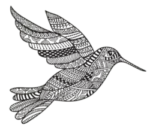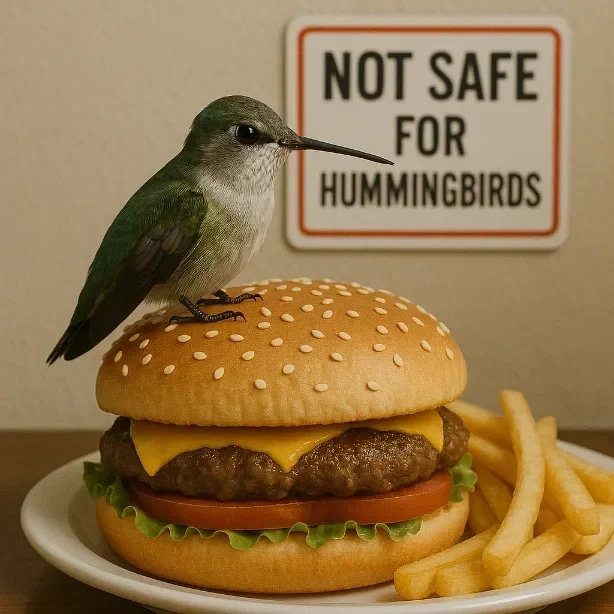(Or: How to Fuel the World’s Highest-Performance Living Engine)
Think of a hummingbird’s diet as the fuel mixture for nature’s most sophisticated living engine. While most people envision these tiny dynamos surviving solely on flower nectar, the reality is far more complex. Their nutritional needs represent one of nature’s most demanding dietary balancing acts, requiring precise combinations of sugars, proteins, and minerals to maintain their incredible metabolic demands.
The Sugar Connection
When it comes to energy requirements, hummingbirds operate in a class by themselves. They must consume their entire body weight in nectar each day just to survive, visiting hundreds or even thousands of flowers in the process. This nectar consumption isn’t just about satisfying hunger – it’s about maintaining the constant energy supply needed to power their remarkable flight capabilities.
The sugar requirements are staggering:
- Consumption of up to double their body weight daily
- Processing nectar within 20 minutes of consumption
- Maintaining blood sugar levels that would be diabetic in humans
Imagine trying to process the equivalent of 155 pounds of sugar (relative to body weight) every day while maintaining perfect metabolic control. This is the daily reality for hummingbirds, their bodies having evolved specialized systems for processing these enormous sugar loads without suffering the negative effects that would kill most other creatures.
The Protein Puzzle
While nectar provides essential energy, hummingbirds face a crucial challenge: sugar alone cannot sustain life. They require protein for muscle maintenance, feather growth, and overall health. This is where their hunting skills come into play – yes, hunting. These diminutive birds are actually accomplished predators of small insects.
Their insect-hunting capabilities include:
- Catching tiny insects in mid-flight
- Plucking small spiders from their webs
- Gleaning insects from leaves and bark
A typical hummingbird might capture hundreds of tiny insects each day, demonstrating remarkable accuracy and agility in their pursuit of protein. This insectivorous behavior becomes particularly important during breeding season, when female hummingbirds need extra protein for egg production and chick development.
The Mineral Balance
Beyond sugar and protein, hummingbirds require a precise balance of minerals to maintain their high-performance physiology. They obtain these essential nutrients through a combination of nectar, insects, and occasionally, mineral-rich soil or ashes.
Essential mineral sources include:
- Trace elements from flower nectar
- Minerals from consumed insects
- Strategic sampling of soil or ash deposits
The birds show remarkable ability to detect and seek out specific mineral sources when their bodies require them, demonstrating a sophisticated form of nutritional intelligence.
The Daily Diet Dance
A typical day in the life of a feeding hummingbird represents a masterclass in energy management. Starting at dawn, they must quickly replenish energy stores depleted during their overnight torpor state. Throughout the day, they maintain a precise balance between energy intake and expenditure.
Their feeding schedule typically includes:
- Early morning intensive feeding
- Regular nectar feeding throughout the day
- Strategic insect hunting during prime activity periods
- Pre-dusk energy loading for overnight survival
This constant balancing act requires remarkable physiological adaptations, including the ability to anticipate energy needs and adjust feeding behavior accordingly.
The Nectar Selection Strategy
Not all flower nectar is created equal, and hummingbirds show sophisticated discrimination in their nectar source selection. They can assess sugar concentration with remarkable accuracy, often preferring flowers offering nectar with about 25% sugar content – coincidentally, the optimal concentration for energy absorption.
Their nectar preferences consider:
- Sugar concentration levels
- Nectar volume per flower
- Energy required to access the nectar
- Rate of nectar replenishment
Special Nutritional Periods
During certain life phases, hummingbirds must modify their normal nutritional patterns to meet increased demands. Migration periods require massive energy stockpiling, while breeding season demands increased protein intake.
Critical nutritional periods include:
- Pre-migration fattening
- Breeding season protein loading
- Post-winter recovery
- Molting period supplementation
Feeding in the Modern World
Human activities have introduced both opportunities and challenges to hummingbird nutrition. While artificial feeders can provide reliable energy sources, they must be maintained properly to avoid harming the birds.
Safe artificial feeding requires:
- Proper sugar solution mixture (4:1 water to white sugar)
- Regular feeder cleaning
- Strategic feeder placement
- Natural food source supplementation
Conclusion: Nature’s Nutritional Masterpiece
The feeding strategies of hummingbirds represent one of nature’s most remarkable examples of nutritional adaptation. These tiny birds have evolved to process massive amounts of energy while maintaining precise nutritional balance, demonstrating that sometimes the smallest creatures have the most sophisticated dietary needs.
Remember: When you observe a hummingbird feeding, you’re witnessing an extraordinary example of natural engineering at work, processing energy at rates that would overwhelm most other living systems.


